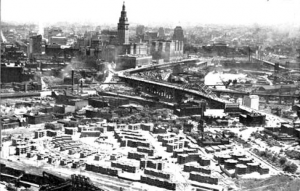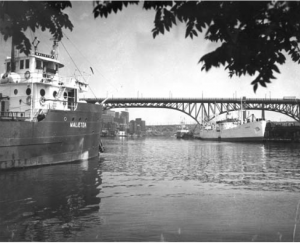After World War II. automobiles, which began about twenty five years before to change transportation planning, now proliferated and jammed the roads. Something had to be done, and that something proved to be highway turnpikes and freeway systems. The Ohio Turnpike Commission built a toll road from the Pennsylvania border to the Indiana border and was sharply criticized because it failed to serve the major cities. Clevelanders had to go to Lorain County, Strongsville or Brecksville to gain access. But it was and still is an overwhelming success. Now the news media criticize the Interstate System as being no solution to the urban traffic problems.
The limited access highways and the Interstate System funded 90 percent by the federal portion of the gasoline tax, are the present-day answer to traffic needs. The Interstate Highway System, whose standards of design and construction are the most advanced in the field of highway engineering is finally nearing completion and the end will soon be reached. However, these systems demanded that bridges, hundreds of them in the Cleveland area, be built quickly and economically. They are now a maintenance problem. The freeway system is of necessity built of look-alikes, for standardization was inevitable. A certain dullness results. What a relief it is to the motoring public to see and occasional stone-masonry or concrete arch bridge, or a ribbed structure of steel. with an open functional design.
But what of the hundreds of bridges we already have? Old bridges are like old friends; they remain faithful in spite of neglect and inattention. Highways demand attention by developing chuckholes and cracking up, but bridges usually conceal their ills, carrying loads much greater than they should, until they collapse. This usually creates great consternation — even out state legislature passed a law after the Point Pleasant Bridge disaster bur provided no money! Bridges are supposed to last forever, at least so the general public seems to think.
How did all these bridges get this way? There are a number of factors – ignorance, complacency, or lethargy — but the principal factor is lack of money. These bridges have been neglected while the country turns its attention to the construction of a much-needed and well-used Interstate Freeway System. During those years, pleas for money to build, repair, or even improve the roads and their bridges usually met with a request for patience. As soon as the Interstate was done, there would be money. Now the Interstate is nearly done, and the popular cry of politicians and commentators is to cut off this highway money and divert it to mass transit or other uses. They have found people who believe them, for state after state has broken the agreement that gas tax money would be spent only on the roads. Now the money that would have improved these old roads and bridges is going for experiments in mass transportation, many untried and untested. Apparently the people who vote for this diversion of funds, this halting of spending money on highways (which sounded so good at the time, did not realize that it meant that the old bridge between their house and their job may well fall before anyone gets enough money to repair it. A new approach to the responsibility of maintenance is needed. The present governmental divisions are not geared to cope with this problem.
The city of Cleveland alone is responsible for about 333 bridges within its municipal boundaries and has been in the business of building bridges for over a century. The county of Cuyahoga has built the major stream crossings in its territory. The Interstate System has resulted in the State of Ohio being responsible for the bridges in the urban areas — but only after a lawsuit decided in favor of the cities over 100,000 population. However, division of responsibility has never been clear.
Early in the 1900’s the City of Cleveland started a grade crossing program in the city. Of the 240 street crossings, fifty-nine were completed by 1914, and steps were taken for thirty more, Perhaps the danger to streetcars was the prime incentive. In any event this was no small undertaking. Consider that the mainline track of the Pennsylvania Railroad from Hamilton Avenue at the Lakefront to Quincy Avenue was elevated on trestle work and the streets crossed the structures. The concrete retaining walls along the right-of-way placed the entire system at the second-story level. The crossing at Euclid Avenue extends over East 55th Street and Euclid Avenue — a remarkable structure in its day — now , eyesore for lack of paint and repairs.
The Big Four grade separations at West 65th Street, Clark Avenue on the West Side, and the New York Central at Detroit, Madison and Lake Avenues were typical of the scope of this concept.
The entire Nickel Plate Railroad on the West Side from West 110th Street to the Cuyahoga River was grade-separated. The City spent over $2,000,000 of matching money on this project which would represent $20,000,000 at today’s prices. Finally, after years of red tape and stalling, a new bridge at East 55th Street and Chester Avenue has been built by Alden Stilson and Associates. The first part of the project was to erect a temporary trestle to keep two of the four Conrail tracks open. At first the railroad wanted to close Chester Avenue. The new railroad bridge is completed and Chester Avenue has been widened to three 35-foot lanes on each side of a center strip.
But there are still grade crossings in the urban areas that need a new look. Would Lakewood, Bay Village and Rocky River — the affluent western suburbs — pay their local share for grade crossing elimination today? These are real hazards as the yearly death toll on their guarded crossings marches on. One solution is to eliminate the railroad. It can be done by routing this trackage from Vermilion over the old New York Central (Conrail) to enter Cleveland via that trackage, and meet the existing grades near Fulton Road where they cross each other’s right-of-way. The existing trackage would make a logical light-rail extension of RTA to the western suburbs from the Detroit-Avenue-98th Street station. The only deterrent is leadership.
Cleveland does not need many new bridges, it needs to replace and refurbish hundreds of the old spans. At least one-fifth of these are in poor condition because repairs and maintenance have been neglected for years.
The total problem of bridge building today and certainly in the future is linked to the highway and freeway systems. Greater Cleveland is backward in its long-range planning for improvements and beautification of the inner city. We need to know the transportation needs, traffic patterns, and modes of transportation estimated for the next ten years, but no such study seems to be underway.
Curiously enough, the age of a bridge is not the chief reason for decay. Like many other structures, the primary problem is proper maintenance. Neglect, corrosion, lack of periodical examination, insufficient forces and skilled supervisors, increased live loads, lack of money — these are the real enemies of a bridge. Public safety demands eliminating hazardous structures.
However it must be admitted that the major problem facing us now and in the future is the economic one. Money for repairs and maintenance are often harder to obtain than money for new structures. The Bridge Responsibility Act of the State Legislature provided inspection but no money. Bridges are never half safe. Does it take another Silver Bridge disaster to make us act? One way to insure competent inspection is to make one agency responsible for all bridges. The local governmental agencies are much too deeply infested by politics to be effective.
The need to put all bride replacement under the state’s Department of Transportation is evident. The need to establish priorities and provide adequate funding cannot be done on a local level. While the State Legislature is not notable for producing long-range solutions, it is the only means we have to insure that a program funded by earmarked monies will not be diverted or made to complete with other programs.
We know of no other reliable alternative. It is costly even to demolish a bridge. The plight of the central cities is well known and no solution seems in sight. The fact remains that many bridges are dangerous. There was a time when the citizens of greater Cleveland took pride in the appearance of their city. Let us hope that all of Cleveland may someday become a city beautiful, and may the citizens once again be stimulated to work towards achieving that goal.


